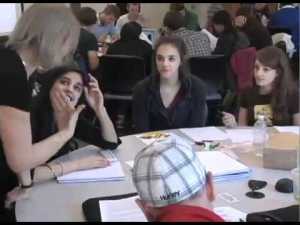Train the Trainer: Mirror, Mirror
November 3, 2012 1 Comment
 Several weeks ago, as I was reviewing about 5,000 end-of-the-semester course evaluations reflecting the work of 25 full-time instructors (plus a slew of adjuncts), I noticed a trend. Oh sure, there were the usual comments about grading policies and reading assignments, but I also noticed that a large number of the surveys mentioned the instructor’s enthusiasm. It was no big surprise that the positive evaluations mentioned the instructor’s obvious love of the subject matter and their enthusiasm in class. This I have seen before. However, I noticed an overwhelming amount of the less-than-perfect evaluations had statements such as “the teacher just didn’t have any passion” or “instructor showed no enthusiasm for the class or the material.” Ouch.
Several weeks ago, as I was reviewing about 5,000 end-of-the-semester course evaluations reflecting the work of 25 full-time instructors (plus a slew of adjuncts), I noticed a trend. Oh sure, there were the usual comments about grading policies and reading assignments, but I also noticed that a large number of the surveys mentioned the instructor’s enthusiasm. It was no big surprise that the positive evaluations mentioned the instructor’s obvious love of the subject matter and their enthusiasm in class. This I have seen before. However, I noticed an overwhelming amount of the less-than-perfect evaluations had statements such as “the teacher just didn’t have any passion” or “instructor showed no enthusiasm for the class or the material.” Ouch.
As educators, we are always looking for that spark that will engage our students, and we’re always told to “be enthusiastic.” I’ve told myself and my faculty that very thing a thousand times. But reading those surveys brought out the Academic in me and I wanted to know “why”. Why is it that gusto of the teacher has such an impact on the student in terms of both engagement and learning? The answer, it seems, is something called “Mirror Neurons.”
Mirror Neurons are a recent discovery, having been first identified in 1980 by an Italian Neuroscientist named Dr. Giacomo Rizzolatti. Dr. Rizzolatti and his team discovered that in a monkey’s brain, the exact same neuron is fired when a monkey performs a specific act, such as grasping a peanut, as when the monkey observed a human perform the same act. It seems that “monkey see, monkey do” might be the exact same thing, at least to the neurons in the monkey’s brain!
 This initial discovery, soon termed “mirror neurons,” led to research on human mirror neurons, and some fascinating implications for education. The two facets of mirror neurons that I find the most interesting and relevant to adult education are: (1) Mirror neurons allow us to feel what someone else is feeling, and (2) Mirror neurons allow us to learn through observation as well as action.
This initial discovery, soon termed “mirror neurons,” led to research on human mirror neurons, and some fascinating implications for education. The two facets of mirror neurons that I find the most interesting and relevant to adult education are: (1) Mirror neurons allow us to feel what someone else is feeling, and (2) Mirror neurons allow us to learn through observation as well as action.
Mirroring Emotions
We’ve all experienced the effect of mirror neurons on our emotional state; in fact, we experience it everyday. You are walking down the street and somebody barely misses getting hit by a car – woah! Your heart starts racing, you recoil in sympathy, you actually feel the fear in your gut. Or you find yourself enjoying a nice movie, having a great time, but as soon as the leading lady gets her heart broken, you can’t stop crying! For decades, such responses puzzled neuroscientists. Now we know that on a certain level, watching something happen to someone else and having it happen to us fires up a reaction in the same part of the brain – right down to a single neuron.
The implication for education is pretty strong; if the teacher is in a good mood, that good mood will rub off on the class. If the teacher is enthusiastic about the subject, your students’ mirror neurons will fire off a corresponding enthusiasm in their brains as well. And we all know that enthusiasm, engagement, and attention all equal enhanced knowledge retention, so anything I can do to enthuse my class is a good start. I don’t know about you, but just knowing about mirror neurons makes me feel much more responsible for my mood in class; who knew we really could affect one another’s outlooks so directly?
Of course, as teachers we have all experienced the flip side of the mirror neurons in action: one student in a foul mood can bring the whole class down, and quickly. Thankfully, as the person standing in front of the room, you can reign in or remove Debbie Downer from the back row before the negative classroom phenomenon that I have always called “the feeding frenzy” gets out of control.
One of the very cool “tricks of the trade” we have as educators is to tie new information to something the student already knows. This is known as “anchoring information” and involves finding an aspect of some a topic that might be familiar to the students– such as the “Charlemagne” of “Corton-Charlemagne” – before introducing new information -such as the geography of Aloxe-Corton. The familiar topic, already safely present in long-term memory, provides an existing framework that helps working memory grasp onto and make sense of new information.
This technique is so profoundly successful that I have often wondered just how we aquire that first bit of new information about a topic. If we have no knowledge to anchor to, what lights the spark that leads to the acquiring of original knowledge? Rote repitition? I hope not. Relevant visuals? They only work some of the time. The answer could lie in mirror neurons.
It seems that new knowledge, including that which occurs in babies learning to make sense of the world and the ease with which young children acquire new languages, is the direct result of the action of mirror neurons. A baby watches the people around her and soon figures out how to move, and walk, and talk.
It sounds amazing, but it just could be true that without the direct learning of new knowledge and skills that is afforded by mirror neurons, there would be no basis on which to build (“anchor”) new learning.
Maximizing the Mirror
There’s one more fascinating implication for education: the effect of mirror neurons is amplified with study. This was proven at a 2003 study at the University College of London, led by Dr. Daniel Glaser, that tested mirror neurons at a dance demonstration. The test found that people who had studied ballet showed more mirror neuron activity during a ballet demonstration than those who had not. It’s a fascinating conclusion, but do you think my students will do their textbook reading assignments if I tell them it will amplify their mirror neuron reaction during the next class?
Perhaps I should just keep that to myself.
The Bubbly Professor is “Miss Jane” Nickles of Austin, Texas



















